
Agaricus bisporus, commonly known as the cultivated mushroom, is a basidiomycete mushroom native to grasslands in Eurasia and North America. It has two color states while immature – white and brown – both of which have various names, with additional names for the mature state, including portobello.

Mushroom poisoning is poisoning resulting from the ingestion of mushrooms that contain toxic substances. Symptoms can vary from slight gastrointestinal discomfort to death in about 10 days. Mushroom toxins are secondary metabolites produced by the fungus.

Clitocybe is a genus of mushrooms characterized by white, off-white, buff, cream, pink, or light-yellow spores, gills running down the stem, and pale white to brown or lilac coloration. They are primarily saprotrophic, decomposing forest ground litter. There are estimated to be around 300 species in the widespread genus.
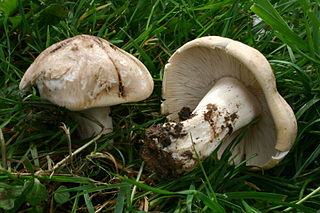
Calocybe gambosa, commonly known as St. George's mushroom, is an edible mushroom that grows mainly in fields, grass verges and roadsides. Deriving its common name from when it first appears in the UK, namely on St George's Day. It appears in March in Italy, a warmer country where it is also a popular mushroom to eat, and is known there as prugnolo. It is also popular in Northern Spain and Southern France, in the Basque Country region and its surroundings where it appears in April. In these regions it is usually eaten sautéed with egg or with bacon.

Entoloma sinuatum is a poisonous mushroom found across Europe and North America. Some guidebooks refer to it by its older scientific names of Entoloma lividum or Rhodophyllus sinuatus. The largest mushroom of the genus of pink-spored fungi known as Entoloma, it is also the type species. Appearing in late summer and autumn, fruit bodies are found in deciduous woodlands on clay or chalky soils, or nearby parklands, sometimes in the form of fairy rings. Solid in shape, they resemble members of the genus Tricholoma. The ivory to light grey-brown cap is up to 20 cm (7.9 in) across with a margin that is rolled inward. The sinuate gills are pale and often yellowish, becoming pink as the spores develop. The thick whitish stem has no ring.

Entoloma is a genus of fungi in the order Agaricales. Called pinkgills in English, basidiocarps are typically agaricoid, though a minority are gasteroid. All have salmon-pink basidiospores which colour the gills at maturity and are angular (polyhedral) under a microscope. The genus is large, with almost 2000 species worldwide. Most species are saprotrophic, but some are ectomycorrhizal, and a few are parasitic on other fungi. The type, Entoloma sinuatum, is one of several Entoloma species that are poisonous, typically causing mild to severe gastrointestinal illness.

Clitocybe nebularis or Lepista nebularis, commonly known as the clouded agaric, cloudy clitocybe, or cloud funnel, is an abundant gilled fungus which appears both in conifer-dominated forests and broad-leaved woodland in Europe and North America. Appearing in Britain from mid to late autumn, it is edible, but may cause gastrointestinal issues.

Orson Knapp Miller Jr. was an American mycologist. He published numerous papers in mycology and was responsible for the naming of many taxa, as well as being one of the authors erecting the genus Chroogomphus. He described Omphalotus olivascens, several species of Amanita, and the ghoul fungus Hebeloma aminophilum.

Entoloma rhodopolium, commonly known as the wood pinkgill, is a poisonous mushroom found in Europe and Asia. In fact, it is one of the three most commonly implicated fungi in cases of mushroom poisoning in Japan. E. rhodopolium is often mistaken for edible mushroom, E. sarcopum. Symptoms are predominantly gastrointestinal in nature, though muscarine, muscaridine, and choline have been isolated as toxic agents.

Entoloma hochstetteri, also known as the blue pinkgill, sky-blue mushroom or similar names, is a species of mushroom that is native to New Zealand. The small mushroom is a distinctive all-blue colour, while the gills have a slight reddish tint from the spores. The blue colouring of the fruit body is due to azulene pigments. Whether Entoloma hochstetteri is poisonous or not is unknown.

Entoloma rodwayi, known as the green stem pinkgill, is a species of fungus in the Entolomataceae family of mushrooms. A yellowish green mushroom with pink gills and spores, it is found in wet forests of Tasmania.
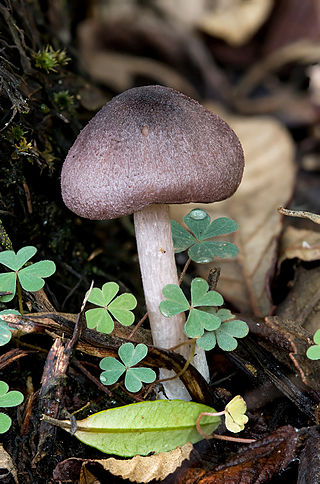
Entoloma austroprunicolor is a species of agaric fungus in the family Entolomataceae. Described as new to science in 2007, it is found in Tasmania, where it fruits on the ground of wet sclerophyll forests in late spring to early winter. The fruit bodies (mushrooms) have reddish-purple caps measuring up to 5 cm (2.0 in) in diameter supported by whitish stipes measuring 3–7.5 cm (1.2–3.0 in) long by 0.2–0.6 cm (0.1–0.2 in) thick. On the cap underside, the crowded gills are initially white before turning pink as the spores mature.

Lyophyllum decastes, commonly known as the fried chicken mushroom, or chicken of the gravel, is an edible species of fungus in the family Lyophyllaceae that grows in clusters on disturbed ground, often near man-made roads in gravel, with a faintly radish-like taste.

Entoloma abortivum, commonly known as the aborted entoloma or shrimp of the woods, is an edible mushroom in the Entolomataceae family of fungi. Caution should be used in identifying the species before eating. First named Clitopilus abortivus by Miles Joseph Berkeley and Moses Ashley Curtis, it was given its current name by the Dutch mycologist Marinus Anton Donk in 1949.

Tricholoma columbetta, commonly known as dove-coloured tricholoma, is an edible mushroom of the large genus Tricholoma. It is found in Europe, where it is eaten in France.

Infundibulicybe geotropa, also known as the trooping funnel or monk's head, is a funnel-shaped toadstool widely found in Europe and in North America. A large sturdy cream- or buff-coloured funnel-shaped mushroom, it grows in mixed woodlands, often in troops or fairy rings, one of which is over half a mile wide. Although edible, it could be confused with some poisonous species of similar colouration and size.
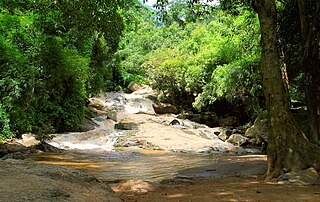
Doi Suthep–Pui National Park is a national park in Chiang Mai Province in Thailand. It includes Wat Phra That Doi Suthep, a Buddhist temple, and Bhubing Palace, the winter residence of the Thai royal family. The park is a protected area for flora, fauna, and habitat.
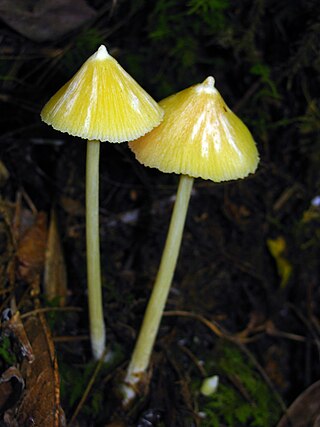
Entoloma murrayi, commonly known as the yellow unicorn Entoloma or the unicorn pinkgill, is a species of fungus in the Entolomataceae family. First described from New England (USA) in 1859, the species is found in eastern North America, Central and South America, and southeast Asia, where it grows on the ground in wet coniferous and deciduous forests. The fungus produces yellow mushrooms that have a characteristic sharp umbo on the top of a conical cap. The mushroom is inedible and may be poisonous. Other similar species can be distinguished from E. murrayi by differences in color, morphology, or microscopic characteristics.
The following outline is provided as an overview of and topical guide to fungi and mycology:
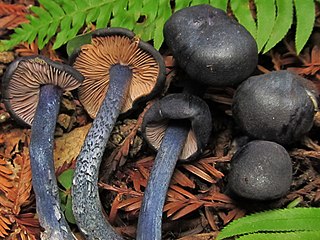
Entoloma subcarneum, commonly known as the indigo leptonia, is a mushroom native to the Pacific Northwest of the United States, belonging to sub-genus Leptonia of genus Entoloma. It is 30–65 mm broad.


















